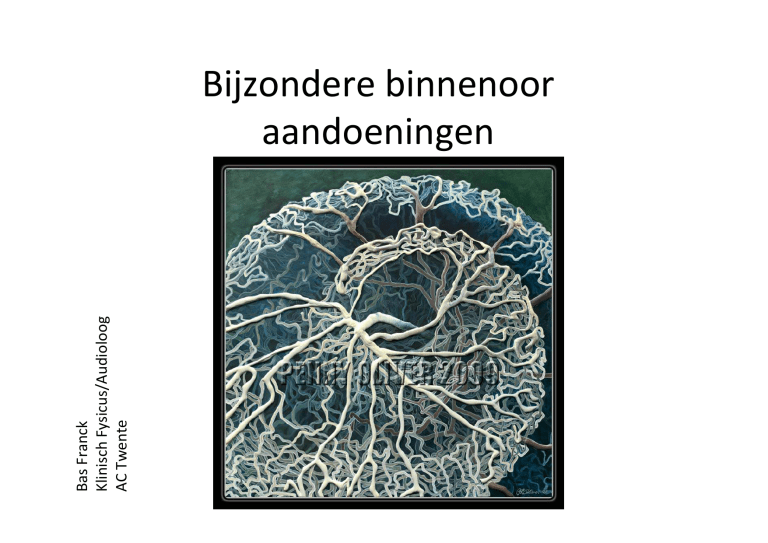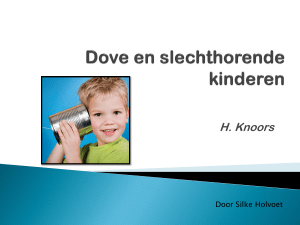
Bas Franck
Klinisch Fysicus/Audioloog
AC Twente
Bijzondere binnenoor aandoeningen
Inhoud
• Thema: EVA en Pendred syndroom
• Uitleg:
‐ Anatomie
‐ Pathologie
‐ Functie
‐ Kenmerken, o.a. bijzondere audiometrie
• Andere third‐window lesions
‐ Uitleg oorzaak
‐ Uitleg verslechtering
Het oor
De normale cochlea
De normale cochlea
Hier gaan we vandaag op inzoomen
Vestibular Aqueduct
EVA
Radiologie
CT Scan
Radiologie
Definities
EVA syndroom
• Enlarged Vestibular Aqueduct Syndrome
Pendred syndroom
• Combinatie van EVA en schildklier disfunctie
Beide syndromen door zelfde gen veroorzaakt
Functie?
Functie ES en ED?
• Niet goed bekend
• Mogelijk zorgen voor correcte hoeveelheid chemicaliën (ionen); metabole functie
Kenmerken
1. Audiometrie bijzonder: a. perceptief gehoorverlies met laagfrequent conductieve component
2. Plotselinge drop in gehoor vaak getriggerd door kleine hoofdtrauma
Gevolgen (in beeld)
Voorbeeld 1
Gevolgen (in beeld)
Colvin IB, Beale T, Harrop‐Griffiths K. Laryngoscope. 2006 Nov;116(11):2027‐36.
Long‐term follow‐up of hearing loss in children and young adults with enlarged vestibular aqueducts: relationship to radiologic findings and Pendred syndrome diagnosis.
Gevolgen (in beeld)
Voorbeeld 1
Laser doppler velocimetry, laten we buiten beschouwing
Gevolgen (in beeld)
Voorbeeld 1
Gemengd?
• Gemengd gehoorverlies
• Waar komt conductieve component vandaan?
Andersom redeneren
• Stel: je kent alleen het audiogram
• Waar komt conductieve component vandaan?
Sta dus even in de schoenen van de audioloog (vaak suf)
Wat is er aan de hand?
1. Ga uit van gehoorverlies middenoor 2. Doe impedantiemetrie:
‐ Tympanogram blijkt normaal
3. Conclusie: geen vocht (OME), geen
onderdruk
Audioloog
Naar KNO arts
Wat is er aan de hand?
• Dan moet er een ander type middenoor aandoening zijn
• Nu oppassen…
Wat is er aan de hand
1. De KNO arts gaat opereren
2. De KNO arts kan niets vinden
3. Conclusie: het middenoor is normaal
Conclusie deel 1
• Pendred syndroom en EVA syndroom geven bijzondere audiometrie: gemengd
• Bijzonder omdat er een conductieve component is die bij nadere KNO chirurgie niet afkomstig is van het middenoor
• Conductief ≠ middenoor probleem
Wat dan?
• Iemand een idee?
Deel 2
• Uitleg vreemde audiometrie
• Uitleg verslechtering van gehoor
Uitleg audiometrie
• Normaal zijn er twee vensters in de cochlea:
Ovale en ronde venster
• Nu derde venster
Uitleg
Artikel: Otol Neurotol. 2008 Apr;29(3):282-9. Conductive hearing loss caused by
third-window lesions of the inner ear. Merchant SN, Rosowski JJ.
Derde venster
Derde venster
• Gevolg: energie vloeit weg via derde venster
• Effect: Laagfrequent air‐bone gap
• AB gap voor f<2000 Hz
• Op basis fysica en anatomische dimensies
EVA model
FIG. 1: verklaringsmodel voor figuren 1a,1b,1c,1d (zie einde presentatie)
A, Normal ear, air conduction. Air‐conducted sound stimuli enter the vestibule through motion of the stapes. There is a pressure difference between the scala vestibuli and the scala tympani, resulting in motion of the cochlear partition. The volume velocities of the oval and round windows are equal in magnitude but opposite in phase. B, Third‐window lesions, air conduction. Acoustic energy is shunted away from the cochlea. The shunting occurs primarily at low frequencies.
C, Normal ear, bone conduction. Inequality in the impedance between the scala vestibuli side and the scala tympani side of the cochlear partition. As a result, there is a pressure difference across the cochlear partition, resulting in motion of the basilar membrane that leads to perception of bone‐conducted sound. D, Third‐window lesions, bone conduction. A third window increases the difference between the impedance on the scala vestibuli side and the scala tympani side of the cochlear partition by lowering the impedance on the vestibuli side, thereby improving the cochlear response to bone conduction. Classificatie
I. Audiometrie
• Perceptief
• Conductief
II. Plaats van de laesie
• Buitenoor
• Middenoor
• Binnenoor
DUS Bij EVA is er dus sprake van een conductief verlies in het binnenoor
Uitleg progressie
• Even terug: Plotselinge drop in gehoor vaak getriggerd door kleine hoofdtrauma
• Hoe kan dat?
• Hoe ontstaat gehoorverlies bij EVA?
Vestibular Aqueduct
EVA
Ontstaan gehoorverlies
1. Plotselinge fluctuatie in intracraniele druk
2. Door ED, ES sterkere drukgolf naar labyrinth (soort mini‐tsunami)
3. Cochleaire schade door:
–
–
–
–
–
endolymfatische hydrops
perilymfatisch fistel (ruptuur van ronde venster)
ruptuur van membraan van Reissner
biochemische ruptuur
…
Dit is nog niet duidelijk
Conlusie deel 2
•
•
–
–
Vermijd contact sporten (mechanisch trauma)
Vermijd grote, snelle drukvariaties
Barotrauma (duiken, snel dalen/stijgen met vliegtuig)
Akoestisch trauma (klap op oor, explosie/rotje)
Conlusie deel 2
• Uitleg audiogram lastig
• Instellen hoortoestel niet triviaal: rekening houden met conductieve component?
Genetica
• UMC Nijmegen
• Blijkt steeds duidelijker dat bepaalde genetische mutaties effect hebben op
verschillende onderdelen van de cochlea
Goed om te weten
• EVA/Pendred studie 2006: alle 27 mensen hebben gehoorverlies
• 37% van EVA progressief gehoorverlies
• Progressie bij Pendred groter dan bij EVA
• Vorm audiogram heel verschillend
Voorbeeld 2,3,4
Voorbeeld 1: laagfrequent gehoorverlies
Voorbeeld 2
helmvormig
Voorbeeld 3
hoogfrequent
Voorbeeld 4
vlak
Third window lesions
Artikel: Otol Neurotol. 2008 Apr;29(3):282-9. Conductive hearing loss caused by
third-window lesions of the inner ear. Merchant SN, Rosowski JJ.
Third window lesions
Classificatie TWL
1. Anatomisch discrete laesies:
‐ semicircular canals (superior, lateral, or posterior canal dehiscence)
‐ bony vestibule (large vestibular aqueduct syndrome, other inner ear malformations)
‐ cochlea (carotid‐cochlear dehiscence, X‐linked deafness with stapes gusher, etc.) 2. Anatomisch diffuse laesies: ‐ Paget disease (multiple microfracturen), deze gedragen zich als
een reeks diffuse derde windows
Bedankt voor de aandacht
EVA diagnostiek
Lesion
Air-bone gap
Bone conduction thresholds
Middle ear
Third-window lesion
0–60 dB, may involve all
frequencies
0–60 dB, greatest at frequencies
<2,000 Hz
Rarely < 0 dB
Acoustic reflex
Absent
VEMP response
Absent
OAEs
Absent
Umbo velocity on laser Doppler
vibrometry
Sound- and/or pressure-induced
vertigo
CT/MRI scan
Exploratory tympanotomy
TABLE 2
Differentiating middle ear from third‐window lesions
+ tympanometrie 226 en 1000 Hz probe frequentie
SCD = Superior Canal Dehiscence
May be negative (−5 to −20 dB or
better) for frequencies <2,000 Hz
Present
Present, thresholds lower than
normal
May be present
Variable: low normal-stapes
fixation; abnormally low-malleus
fixation; abnormally high-ossicular
discontinuity
High normal
Absent
May be present (SCD)
May show middle ear abnormality
Inner ear lesion
Ossicular lesion, fixation or
discontinuity
Normal ossicular mobility










